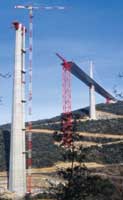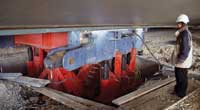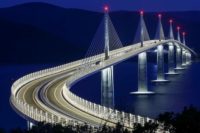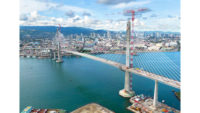Multispan, Cable-Stayed Crossing Is High-Level Landmark
 From the small southern French town of Millau, the 2.5-kilometer-long deck of the worlds largest multispan, cable-stayed bridge seems to be sliding imperceptibly over the horizon. On piers as tall as skyscrapers, unseen hydraulic "translateurs" are feeding the steel decks from assembly lines on both sides of the valley toward an expected rendezvous some 270 m over the Tarn River this June.
From the small southern French town of Millau, the 2.5-kilometer-long deck of the worlds largest multispan, cable-stayed bridge seems to be sliding imperceptibly over the horizon. On piers as tall as skyscrapers, unseen hydraulic "translateurs" are feeding the steel decks from assembly lines on both sides of the valley toward an expected rendezvous some 270 m over the Tarn River this June. Even with a short 39-month contract to design in detail and build the $410-million bridge, the private-sector sponsor has brought completion forward a few weeks to this December. Contractors have found their pace, so the early opening should happen "if the weather stays favorable," says Marc Legrand, director general of Compagnie Eiffage du Viaduc du Millau (CEVM).
 |
| MASSIVE Using GPS produced formwork's 4-mm accuracy. (Photo by Daniel Jamme) |
With pylons reaching higher than the spire of New Yorks Chrysler Building, the viaduct is the last major link in the A75 highway between Bézier and Claremont-Ferrand. Its construction will relieve seasonal congestion around the town of Millau and was ordered by the transportation ministry, partly because of the difficult hilly terrain it must cross.
To avoid the road snaking down the valley sides, the viaduct will carry the highway on eight, generally 342-m-long spans, each supported by a single, central plane of stays. The deck is a 27.75-m-wide aerodynamic steel box, widened by curved nosings supporting wind barriers. It is 4.2 m deep with two central vertical stiffening plates set 4 m apart over the launching mechanism positions.
Seven equally spaced concrete piers rise between 75 m and 245 m above the valley floor to support the steel box deck. The piers split in two near their tops, along the line of the deck, to merge with the inclined legs of 87-m-high steelwork pylons.
|
The slenderness of the piers and length of deck dictated the construction process, devised by Paris-based contractor Eiffage S.A. The groups CEVM division has a build-operate-transfer contract for the viaduct, with 75 years to run. Its subsidiary, Eiffel Construction Métallique S.A., is handling steelwork, which accounts for just over half the total cost, says director Marc Buonomo. Eiffage T.P., another division, is doing the rest.
Flexibility also was an issue for designers of the structure. That is because the viaduct has six continuous stayed deck sections and only two distant anchor spans, says Michel Virlogeux, CEVM's adviser (8/5/96 p. 13). His cure was to split the pier tops into two arms ending some 15 m apart. They provide a wide base to counter the pylons rotational tendency. Their reduced flexibility allows them to flex as the deck expands in the sun, he explains.
 |
| HIGH AND LONG Millau Bridge will allow motorists to avoid congestion on narrow Tarn River valley roads. (Photo by Peter Reina for ENR) |
Virlogeux promoted the multispan concept for the Millau site over a decade ago, when he ran the government's large-bridge design organization. Even after quitting the civil service, he stuck with the project through its eventful evolution and retained his design influence.
Seeds of the Millau project took root nearly 20 years ago and were nurtured by the governments Service dEtudes Techniques des Routes et Autoroutes, where Virlogeux headed the big bridge division until the mid-1990s. Because of the viaducts prominence, the government ordered a design competition, with an emphasis on architecture.
After leaving SETRA, Virlogeux teamed with the British architectural firm Foster & Partners to win the competition in 1996. The team also included three Paris-based firms, now among Eiffages designers. Europe Etude Gecti S.A. leads concrete design with Thales Group and Société DEtudes R. Foucault et Associes. Later, Belgiums Bureau Greisch S.A., Liège, joined to confirm the governments calculations and design the steelwork along with its erection method.
On winning the competition, Fosters then project director, Tim Quick, conceded the design was "very much an engineering generated form" and the product of "collaboration with a set of good engineers." The architects knew what they wanted aesthetically, but also understood engineering demands, says Virlogeux.
Curving the long crossing for better sight lines, specifying multifaceted pier profiles and the sculptured wind barrier supports are among architectural features dictated by the Foster team. Their design, with an embargo on all but the smallest visible deviations, became the basis of the governments subsequent procurement.
Though planned as a public-sector project, the viaduct came to market just as the French government was approaching build-operate-transfer procurement as an alternative to using its traditional highway network franchises. In 2000, the government prequalified four potential bidders for the long-term contract.
Along with two largely foreign groups, including Swedens Skanska A.B. and Spains former Dragados S.A., was a formidable multi-firm, Paris-based consortium. It included the giant contractors Bouygues S.A. and what now is Vinci Group. Facing that galaxy of rivals, Eiffage stood alone.
By bidding singly, Eiffage avoided having to make decisions by committee, inherent in joint ventures, and eliminated potential conflicts of interest, says CEVMs Legrand. And by taking the unusual step of financing the project with its own balance sheet, Eiffage cut out delays and costs of more conventionally raised bank loans secured by the projects predicted revenue, he adds.
Eiffage is a relatively new group formed by the merger during the last decade of some medium-size French contractors. The group now is substantially owned by its staff and reports annual sales of around $8.5 billion, mainly in France. Its most recognizable subsidiary is Eiffel, with a lineage reaching back to the Victorian builder of the eponymous Paris tower, notes Buonomo.
 |
| CUSTOMIZED Translators eliminate friction to push deck sections. (Photo by Peter Reina for ENR) |
During 2000, Eiffages bidding team was under strict instruction to eliminate all important uncertainties and ensure the bid price would be accurate, says Buonomo. Trawling through every engineering detail raised Eiffages engineering cost to nearly $4 million, he adds. Legrand puts the total bid cost nearer to $6.5 million, including commercial and legal issues. "If we had lost the bid, we would have lost [it all]," he says.
In their calculations, Eiffage engineers investigated both steel and concrete possibilities for the bridge, finding the costs to be close, says Buonomo. But the steel option was more slender and allowed faster construction. A concrete deck would have been greatly heavier, over 0.5 m deeper and needing three times as many cables.
With the government contract secured in early October 2001, Eiffage immediately began earthmoving. Altogether, 360,000 cu m of terrace excavation was needed to create foundation space for the piers, says Thomas Tieberghien, Eiffage T.Ps director of works. Four excavated piles, up to 5 m dia and reaching around 15 m down, underpin each hollow pier. The piles are capped with rafts, which are about 5 m deep and contain around 2,000 cu m of concrete.
The piers are all identical above a common level. Their lower plan shape resembles a diamond with points squared off. At the base, the biggest piers footprint is 25 m by 17 m. Viewed from the side, the piers taper slightly and split into two prongs 90 m below the deck level. The taper of the other elevation is more pronounced and follows a gentle parabola, with the width reducing to 11 m at the top.
 Click here to view chart
Click here to view chart
 |
| RISING HIGH Temporary steel support structures reduce distance between piers for placing deck sections with specialty designed pushing device. (Photo by Daniel Jamme) |
With the constantly variable geometry and demands for high-quality finishes, the formwork performance has been "fantastic," says Virlogeux. Eiffage is casting piers in 4-m lifts with self-climbing external formwork and using cranes to raise internal shutters. The contractor ruled out slipforming to ensure a surface good enough for the viaducts 120-year design life, says Tieberghien.
For the same reason, Eiffage ordered steel rather than wood shutters from its German-based supplier Peri GmbH, Weissenhorn. They produce a good finish and reduce the number of disfiguring bolt holes, says Tieberghien. But, being made of 6-mm steel, they are twice the load for the 270-m-high tower cranes. Workers climb the tall piers on rack and pinion hoists in trips lasting up to eight minutes.
To speed up formwork assembly, Eiffage used satellite-based global positioning, says Tiberghien, who is delighted with the 4-mm accuracy recorded. "I didnt believe in GPS [for this] at the beginning" he says. "I think its the beginning of this kind of precision. Ten years ago, it was 10 cm," he adds. His surveyors also developed software to predict pier distortions under the suns heat, avoiding the need for slower site measurements in making formwork adjustments.
A snag in the seemingly smooth concrete casting was the increase of prestressing at the pier tops, says Tiberghien. Acting under Virlogeuxs advice, the owner ordered more vertical stressing to bolster ties between the deck and piers. The result was haut couture rebar detailing, he adds. "We had to do drawings at scale one-to-one to prepare the reinforcing."
Those pier top modifications cost around $2 million, demanding another set of formwork to compensate for longer casting. But at least Eiffages short command chain made the decision a fast one, says Tiberghien.
Altogether, the top 5 m of pier arms contain 60% more steel than the rest because of high forces from deck translators, cantilevering from their sides. Four of these 12-tonne devices per pier lift and advance the deck, supporting loads of up to 2,400 tonnes each in the windiest conditions, says Jean-Yves Belforno, designer Greischs project manager.
This translation mechanism was devised by Eiffel and Greisch from the start because pushing the deck from each end was ruled out. With frictional resistance, each pier top would have deflected excessively. Instead, the four 4-m-long pushing devices on each support eliminate friction between the sliding deck and piers.
Each translator is mounted on four to six vertical hydraulic cylinders on the support to balance the deck. Within each device, a single horizontal cylinder powers a sliding wedge that lifts the deck 2 cm off the pier bearing, transferring its weight to low-friction skids on the translator. Two other horizontal cylinders then act, pushing the deck 60 cm forward, with the whole cycle repeating many times.
 |
|
IN MOTION A permanent pylon with some of its 11 cables supports cantilevered deck section. Tension varies, sometimes dissipating as decks flex. (Photo by Peter Reina) |
During deck launching, translators are finely synchronized to avoid unbalanced forces bending the piers. Each device is operated by a computer connected by wire to a central mobile controller. Glendale, Wis.-based Enerpac Inc. supplied controls and hydraulic equipment, all assembled into translators by Germanys Maurer Söhner GmbH, Munich.
Altogether Eiffage paid about $9 million for the 64 translators now at work, says Buonomo. They are operating at the abutments, atop each pier and on seven temporary steelwork props at all but one of the mid-spans, to halve the launch lengths. Like tower cranes, the 12-m-wide props are raised in pre-assembled sections by hydraulic jacks in the supporting frame.
The tallest temporary prop already reaches over 170 m above the valley floor. A prop 100 m taller would have been needed near the river, three spans from the north abutment. But constructing it was not feasible. Instead, Eiffel is timing the launching for the approaching deck sections to meet near the highest point, cantilevering around half a span from either side.
Launches lasting about three days happen roughly every five weeks, as enough deck is built at the abutments. Steel erectors are assembling the decks on production lines reaching back several hundred meters. From near Marseilles, they receive 4-m-wide by 4.2-m-deep boxes forming the decks spine. They then weld on sections made in Lauterbourg, near Germany, to complete the full profile. Painters then do their work, before wind barrier arms are attached at the head of the next launch.
When a half span of 171 m is built, the deck is launched, curving tightly down into the first void. To reduce the extent of temporary excavations behind the abutments, the contractor assembled the production and jacking equipment at the final road level, making the deck nearly 5 m too high.
At the front of each deck, a permanent pylon with some of its 11 cables holds up the cantilevering end. Tension in these cables vary widely, sometimes dissipating completely as decks flex in motion, says Virlogeux.
Projecting from the end of each deck is a steel frame cantilever that reaches out some 50 m toward the awaiting pier. The front 36 m of the cantilever is a light structure designed to steady the deck horizontally as it makes contact. The rear 13 m is much more substantial and is equipped with vertical jacks. Its job is to raise the decks dipping end to land at the pier top.
Checking deck safety in windy conditions occupied much of Virlogeuxs time in reviewing the contractors launching proposals. When the deck is parked and temporarily tied down if needed, it is almost as safe as the final structure, he says.
For launching to proceed, Eiffel must have wind speed forecasts of under 72 km per hour for three successive days. If winds exceed 85 km per hour in mid-launch, the operation must stop, Virlogeux says.
With steelwork fabrication starting in April 2002, and site assembly following the next September, the deck is due to complete its journey over the valley this June. Then, the remaining 670-tonne pylons will be assembled from box sections on site for installation. Each pylon will be transported on its side to a lifting frame over its allotted pier. There, it will be hooked at its center of gravity to be raised, becoming vertical at the same time.
With the last pylon due for placing this August, workers from Paris-based Freyssinet International are scheduled this summer to return to Millau. In one of the projects last operations, they will install the remaining Spanish-made cables and stress them to bear the weight of the viaducts first traffic, avoiding Millau en route to Christmas by the Mediterranean Sea.






